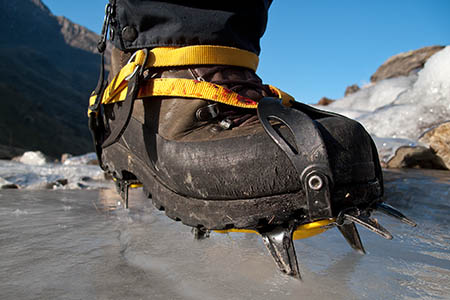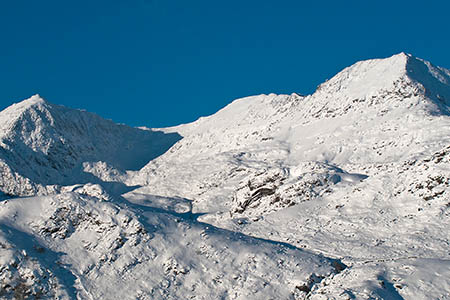
Crampons are essential on Snowdon's paths while winter conditions prevail. Photo: Snowdonia National Park Authority
Mountaineering experts are urging anyone heading for Wales’s highest mountain to be prepared.
Snowdon was whipped by 100mph winds recently and all its main paths are covered in ice.
The British Mountaineering Council said: “Going into the mountains where there is snow and ice requires specific equipment, skills, knowledge and awareness in addition to those used in summer hillwalking, and the consequences of making errors can be much more serious.
“This is true anywhere, but the booming popularity of Snowdon means the 1,085m (3,560ft) high mountain sees more than its fair share of visitors who aren’t equipped to deal with the harsh, often hazardous conditions.”
Elfyn Jones, the BMC’s access and conservation officer for Wales, said: “Snow and ice can transform mountains completely, adding an extra dimension of spectacle. They can be wonderful places to be, but they can also introduce hazards and dangers you don’t find in summer.
“A lot of people think Snowdon is an easy mountain to climb because there are wide paths to the summit and a cafe on top. But Snowdon in winter is a very different place to Snowdon on a sunny summer day.
“The weather is much harsher, with strong winds, sub-zero temperatures and blizzards par for the course. Visibility can be very bad, making navigation challenging.
“And snow and ice can often cover those paths, not only obscuring the way but forming potentially hazardous slippery slopes, which you need an ice axe and crampons to negotiate safely. In heavy snow conditions there can be a risk of avalanches.
“Mountain rescue teams are constantly kept busy in winter responding to incidents caused by people setting off up Snowdon not knowing what they’re letting themselves in for. These incidents could so easily be avoided by people having a bit of prior preparation and know-how.
“We’re not saying ‘don’t go up Snowdon in winter’. If you think the views are good in summer, you should see them under a layer of snow – it can be hugely beautiful and rewarding. We’re just saying ‘be prepared’.”
Rob Johnson, chair of Llanberis Mountain Rescue Team, said: “Llanberis MRT shares the view of the BMC that the winter mountains offer an amazing experience.
“We are keen that anyone who takes on the challenges and rewards of climbing Snowdon in winter does so with their eyes open as to just how challenging those conditions can be.

An ascent of Snowdon can be rewarding for those who are prepared. Photo: Snowdonia NPA
“Last week the summit winds topped 100mph and there is currently snow and ice on all of the paths. It is important that people have the appropriate equipment such as ice axe, crampons, waterproof clothing, insulated clothing, map, compass and most importantly the knowledge of how to use it.
“We also urge people to base their plans on an up-to-date weather forecast and match their objective with the conditions and their experience.
“Never be afraid to turn back and remember it is often more challenging to descend in snow and ice than it is to head uphill.”
Snowdonia national park wardens produce daily reports detailing the ground conditions and snow level on the mountains, including advice on the appropriate equipment required. This information is available on the Met Office Snowdonia mountain weather forecast.
Details of winter skills courses run by the BMC, and more information on winter mountaineering and walking are on the council’s website.